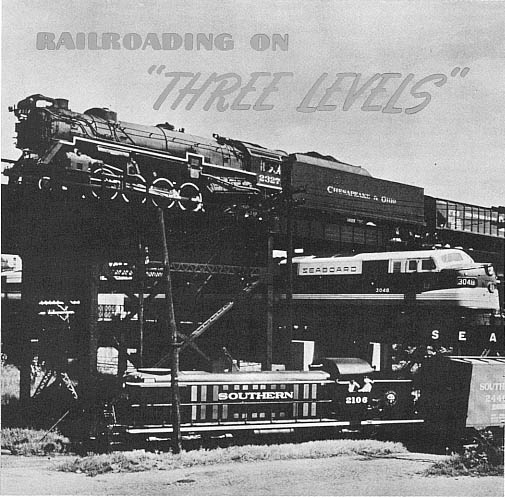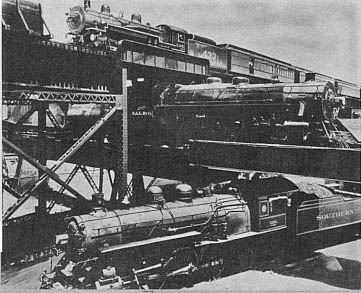

What looks at first glance like a photographer's idea of a practical joke is really a picture of what is probably the only three-Ievel railroad crossing any- where. Ii. Richmond, Virginia, just south of Main Street Station at Byrd Street, tracks of three railroads-the Southern, the Seaboard and the Chesapeake and Ohio- intersect at three separate levels.
On the "ground floor" runs the main line of the Southern's Richmond division, tracks first laid in 1861. Pass- ing above it on a viaduct is the main line of the Seaboard Air Line Railroad's Virginia division. Above that, on one of the longest railroad trestles in North America, sweeps the main line of the James River division of the Chesapeake and Ohio. Both the C&O overpass and the Seaboard viaduct-which is both overpass and under- pass-were built in 1900.
Ever since the triple crossing was built, photographers have cajoled and connived continually for the chance to focus their cameras on this railroad oddity when it was filled to the brim with three locomotives. If three trains ever occupied the crossing at once by coincidence- and the odds are long that they haven't-no photographers happened to be around. But three times since 1900 the railroads involved have undertaken the trouble- some project of "posing" three trains at the crossing.

Three steam engines chugged onto the crossing for the first official portrait in 1911. Then in 1926, when railroad officials had partly forgotten how much trouble it was, three more steam locomotives of a newer vintage were photographed at the crossing. Last fall the cycle came round again and the three companies sent locomotives to the crossing for the color portrait featured on the cover of the October 23, 1949, issue of the Richmond Times-Dispatch Sunday Magazine.
In February (Page 29} Ties printed the most recent photograph of the Richmond crossing. Reader interest has prompted the editors to record here a more detailed picture story. In fifty years Richmond's famous triple crossing has changed little but the brand of motive power posing on its three levels has seen considerable alteration. Steam locomotives shown in the first portrait ( bottom of page} look like museum antiques to today's railroaders. The 1926 portrait ( at right} shows bigger, more powerful steam hogs. But the most recent picture looks almost like an advertisement for the Diesel-electric locomotive-it's Diesels, two to one!
Representatives of the three companies met weeks before the picture was taken. After consulting freight and passenger schedules and considering the chances of plan-wrecking late runs on all the lines, they agreed that on a certain Thursday, at 12:01 noon, three locomotives would converge on the crossing, remain for exactly 10 minutes, and then go about their business. Photographers would have to pray for good weather and good luck.

The weather was clear and the sun shining when the three locomotives moved into position at the appointed instant: a lS00.hp Southern Diesel electric road switcher ; a 3000-hp Seaboard passenger Diesel; and a C&O K.3 steam freight locomotive. After 10 minutes-during which the photographer, Herbert Wilburn, squinted into his viewer and shouted orders--the triple crossing was cleared and the railroads went about their business as if nothing had happened.
(Ties' thanks to the Richmond Times-Dispatch for the pictures and the story .)
|
|
 |
